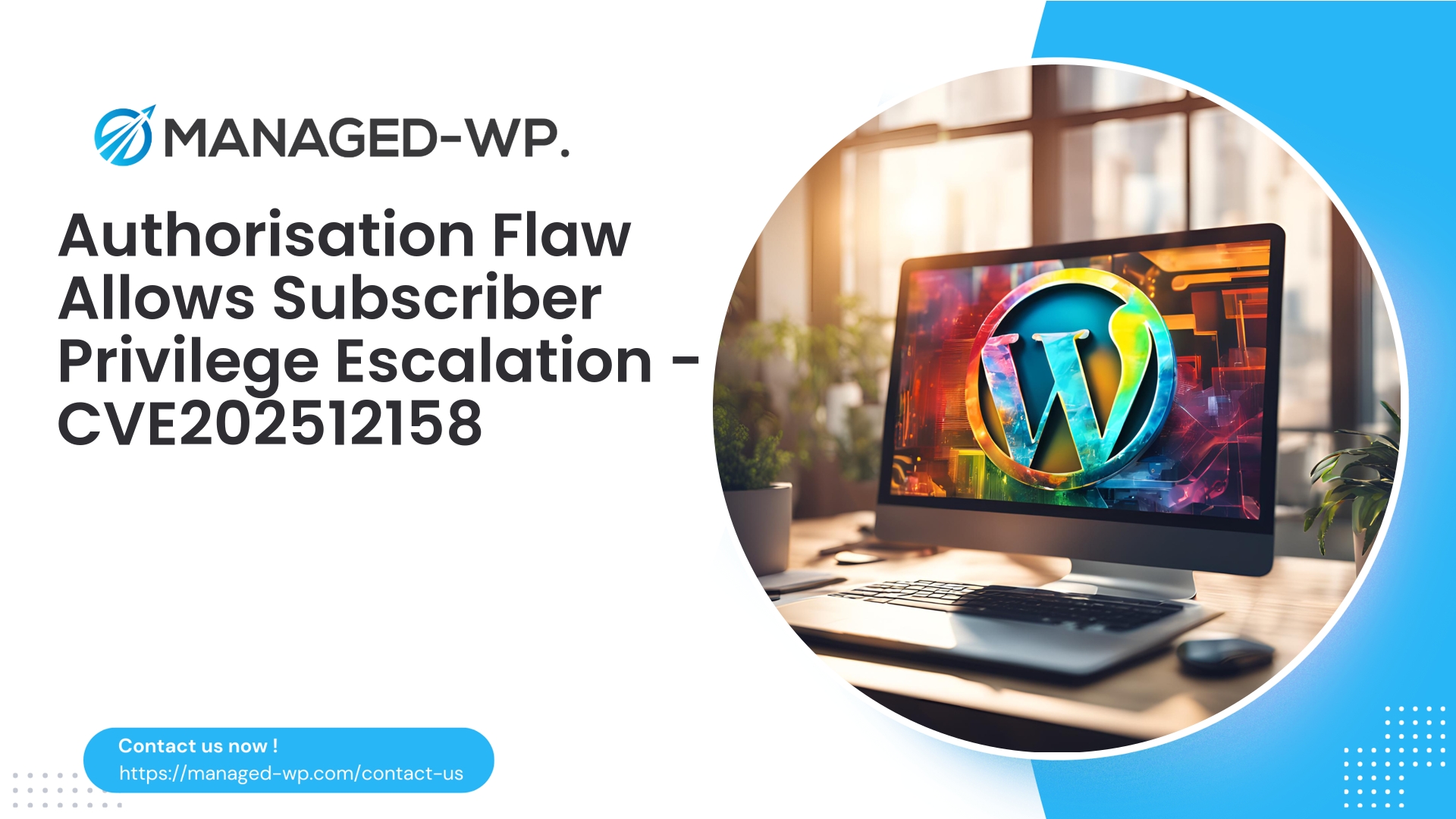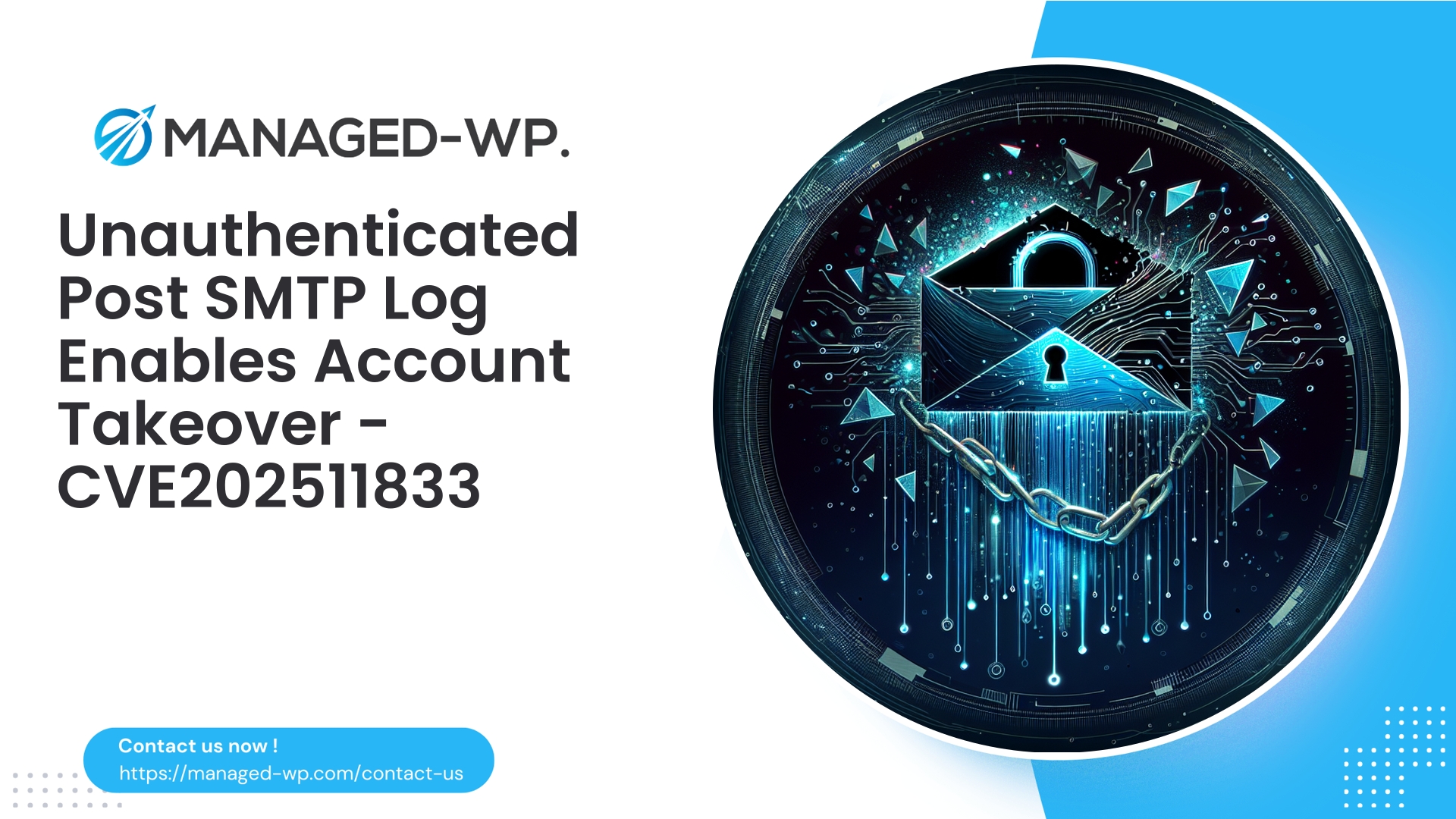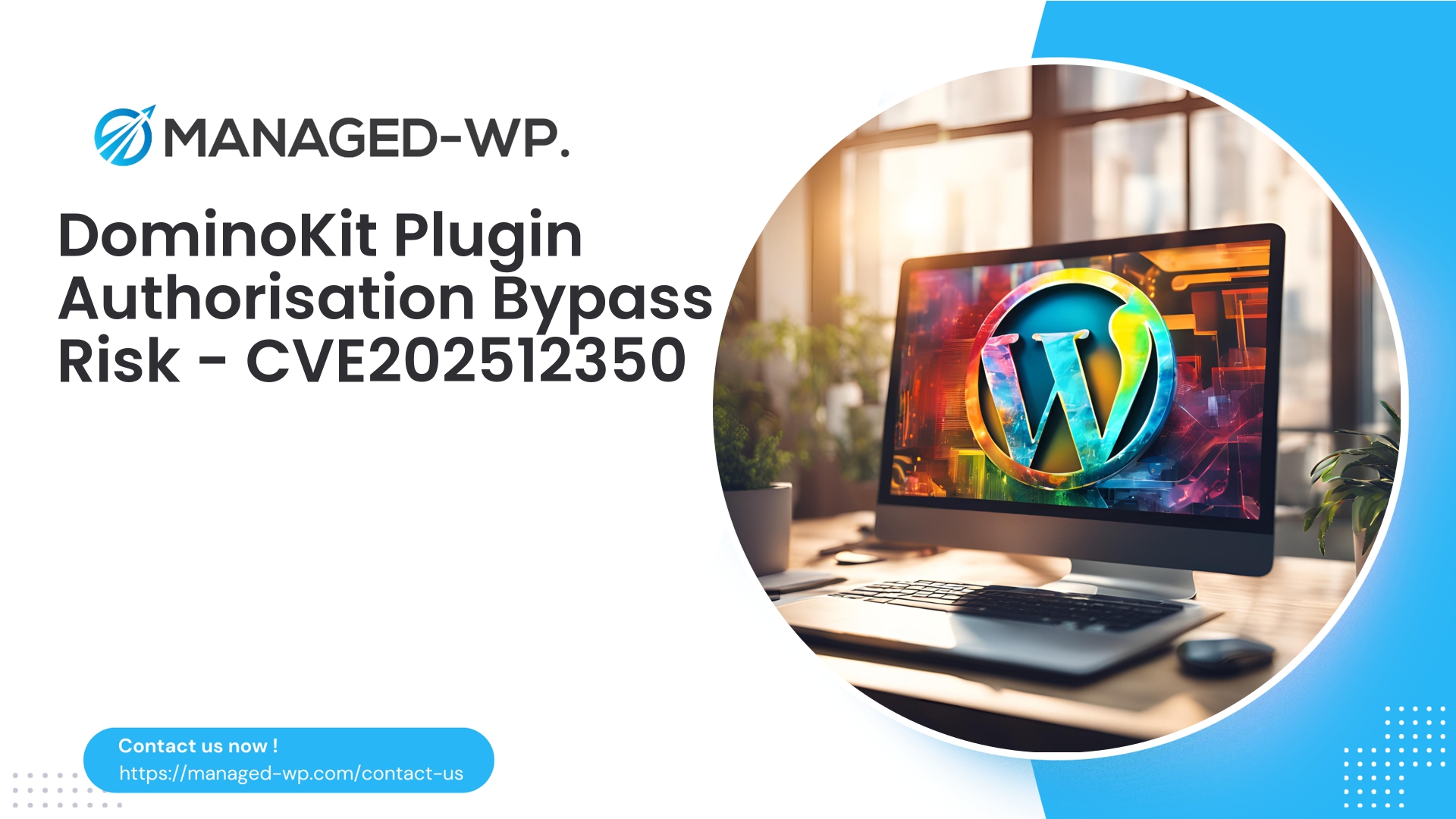| Plugin Name | Simple User Capabilities |
|---|---|
| Type of Vulnerability | Privilege Escalation |
| CVE Number | CVE-2025-12158 |
| Urgency | Critical |
| CVE Publish Date | 2025-11-04 |
| Source URL | CVE-2025-12158 |
Urgent Security Advisory: Simple User Capabilities ≤ 1.0 — Privilege Escalation (CVE-2025-12158) and Immediate Response Guidance
Date: November 4, 2025
Author: Managed-WP Security Research Team
Overview: A critical privilege escalation vulnerability, designated CVE-2025-12158, has been disclosed affecting the WordPress plugin Simple User Capabilities (version 1.0 and earlier). This flaw permits unauthorized users—even those with minimal or no authentication—to escalate their privileges, potentially gaining full administrative control. This advisory provides a detailed risk assessment, practical detection techniques, immediate mitigation steps, strategic hardening measures, and how Managed-WP’s firewall services can safeguard your WordPress site during this critical window.
Why This Matters Now
If you operate WordPress sites where Simple User Capabilities is installed—or manage environments allowing user registrations with low-level privileges—this vulnerability represents an immediate and severe risk. Rated with a CVSS score of 9.8, privilege escalation vulnerabilities can enable attackers to create admin accounts, execute malicious code, alter content, or access sensitive credentials.
Our goal at Managed-WP is to equip security-conscious site owners and developers with actionable, no-nonsense advice so you can respond swiftly, regardless of your site’s size or complexity.
Technical Summary
- CVE: CVE-2025-12158
- Impacted Software: Simple User Capabilities WordPress Plugin
- Vulnerable Versions: 1.0 and below
- Vulnerability Type: Missing authorization checks leading to privilege escalation (OWASP A07 Identification and Authentication Failures)
- Severity: Critical, CVSS 9.8
- Disclosure Date: November 4, 2025
- Reported By: Security researcher “D01EXPLOIT OFFICIAL”
- Patch Status: No official fix published yet
The vulnerability primarily arises from inadequate authorization enforcement on plugin functions that modify user roles and capabilities, allowing low-privilege or unauthenticated users to elevate their permissions improperly.
Note: We intentionally exclude reproducing exploit code or attack vectors in this advisory to avoid assisting malicious actors. Our focus remains on safe guidance and containment.
Why This Vulnerability Is Extremely Dangerous
- Severe impact after exploitation: An attacker with escalated privileges can install backdoors, create or delete admin accounts, manipulate site content or configuration, and access confidential data such as API keys.
- Easy automation: Exploit attempts on high-severity vulnerabilities are often fully automated and rapidly spread across vulnerable sites, multiplying damage quickly.
- Lateral escalation risks: Gaining WordPress admin rights can be a foothold for escalating to server-level access if other misconfigurations exist, complicating recovery.
Given that many WordPress installations allow user registrations at the lowest privilege level (subscriber), this vulnerability poses a widespread threat across the ecosystem.
Potential Real-World Attack Scenarios
- Scenario A — Malicious subscriber elevation: A subscriber exploits the plugin endpoint lacking proper security to elevate themselves or another user to editor or administrator roles.
- Scenario B — Full takeover post-escalation: With administrative access, the attacker installs persistence mechanisms such as backdoors or cron jobs to maintain control.
- Scenario C — Automated exploitation campaigns: Attackers scan for vulnerable instances and execute bulk privilege escalation actions.
- Scenario D — Unauthenticated remote abuse: Some reports indicate that even unauthenticated requests can trigger exploitation, enabling attackers to compromise sites remotely.
Immediate Priority Actions You Must Take
If your sites run the Simple User Capabilities plugin, follow these steps urgently:
- Identify all affected sites:
- Search your infrastructure for the plugin folder (
simple-user-capabilities). - Use management tools or WP-CLI to confirm active installations.
- Search your infrastructure for the plugin folder (
- Deactivate or isolate the plugin immediately:
- Deactivate via the WordPress admin panel or use WP-CLI:
wp plugin deactivate simple-user-capabilities - If deactivation breaks essential functionality, block access to plugin endpoints using your firewall or server rules.
- Deactivate via the WordPress admin panel or use WP-CLI:
- Restrict access:
- Block plugin-specific endpoints that manage roles and capabilities.
- If using a web application firewall (WAF), implement rules to deny traffic to vulnerable endpoints.
- Disable user registrations temporarily if not strictly necessary.
- Change passwords and revoke sessions:
- Rotate all administrator passwords and any suspect accounts immediately.
- Expire active sessions for admin and privileged users.
- Audit user roles and accounts:
- Check all administrative accounts for suspicious additions or changes.
- Remove unauthorized or unknown admin users without delay.
- Backup your entire site:
- Create complete backups of files and databases before proceeding further.
- If compromise is suspected, retain snapshots for forensic examination.
- Increase monitoring:
- Enable logging of admin login attempts, plugin installs, file changes, and PHP error events.
- Watch for anomalies such as unknown admin profiles, changes to critical files, or suspicious jobs.
- Enlist professional incident response if you detect breaches:
- Do not rely solely on plugin deactivation; attackers may have left backdoors.
- Follow a structured incident response and remediation plan or seek expert assistance.
Safe Detection and Forensic Steps
Perform safe, non-destructive checks to verify if your installation has been targeted:
- User and role verification:
- List administrators and editors using WP-CLI:
wp user list --role=administrator --fields=ID,user_login,user_email,roles - Query the database for recently added admin users:
SELECT ID, user_login, user_email, user_registered FROM wp_users WHERE ID IN (SELECT user_id FROM wp_usermeta WHERE meta_key = 'wp_capabilities' AND meta_value LIKE '%administrator%') ORDER BY user_registered DESC LIMIT 50; - Compare with backups or logs to identify suspicious role escalations.
- List administrators and editors using WP-CLI:
- Scan file integrity:
- Check for recently modified PHP files within plugins, themes, and uploads folders.
- Investigate files containing obfuscated code patterns (base64 encode, eval, system calls).
- Use server-side tools for checksums and compare against clean backups.
- Review logs:
- Analyze web server access logs for unusual POST requests or suspicious headers targeting plugin endpoints.
- Inspect PHP error logs for repeated warnings or errors near suspected exploitation times.
- Use WordPress debug logs if enabled.
- Examine scheduled tasks:
- Check WordPress cron events:
wp cron event list - Query database options table for unexpected transient cron entries.
- Check WordPress cron events:
- Run malware scans:
- Use reputable malware detection tools, though treat results as preliminary and validate manually.
Any signs of compromise should trigger urgent evidence preservation and take your site offline or into maintenance mode during investigation.
Containment Measures When Plugin Removal Isn’t Immediately Possible
If Simple User Capabilities is critical for your site and immediate removal is not feasible, implement these mitigations:
- Configure your web server (Apache/nginx) to block public access to the plugin’s PHP files:
location ~* /wp-content/plugins/simple-user-capabilities/ { deny all; } - Restrict plugin admin pages to trusted IP addresses using .htaccess or nginx rules.
- Apply rate-limiting to POST requests targeting plugin endpoints to hinder automation.
- Enforce strong admin credentials and require password rotations and session expirations.
- Monitor plugin endpoints and configure alerts for abnormal activity.
The objective is to limit exposure and exploitation risk while preparing to replace or patch the plugin.
How Managed-WP’s Managed Web Application Firewall Secures You
Our Managed-WP firewall provides advanced virtual patching—an immediate, effective shield against exploitation without modifying your plugin code or forcing deactivation.
Key protections include:
- Blocking access to vulnerable plugin endpoints managing user capabilities and roles.
- Filtering suspicious request parameters and methods (e.g., unauthorized POST requests).
- Enforcing rate limits and IP reputation checks to disrupt automated attacks.
- Preventing unauthorized attempts to alter wp_usermeta or other sensitive database actions.
Managed-WP’s security team continuously monitors new vulnerabilities and rapidly deploys tailored WAF rules covering the latest threats. These virtual patches provide critical time to remediate properly while minimizing risk.
Note: Virtual patching complements but does not substitute for the complete removal or official patching of vulnerable code.
Recommended Remediation Timeline
Immediate (Within Hours):
- Identify affected installations.
- Deactivate plugin, or block endpoints if deactivation is disruptive.
- Rotate admin passwords and expire sessions.
- Backup files and databases immediately.
Short Term (Within 24–72 Hours):
- Audit user accounts; remove unauthorized admins.
- Scan for malware and backdoors, preserving evidence if compromise suspected.
- Deploy WAF virtual patch rules to block ongoing exploit attempts.
- Disable new user registrations if possible.
- Restrict wp-admin access by IP as feasible.
Medium Term (Days to 2 Weeks):
- Remove the Simple User Capabilities plugin and replace with a secure alternative.
- Apply official patches if/when released, after testing on staging.
- Review and tighten site permissions and policies.
- Enable multi-factor authentication for all admin users.
Long Term (Weeks to Months):
- Implement continuous monitoring of user roles and plugin behavior.
- Maintain strict development best practices and authorization testing.
- Ensure regular, verified backups and a tested recovery plan are in place.
Post-Incident Best Practices (If Compromised)
- Contain: Block attacker access and secure evidence.
- Eradicate: Remove malware, backdoors, and unauthorized users.
- Recover: Restore from clean backups; patch vulnerable code.
- Review: Conduct root cause analysis; improve processes to prevent recurrence.
- Notify: Follow legal and privacy obligations if sensitive data was exposed.
Ensure restoration is from backups predating the attack and that the root vulnerability has been remediated before redeploying.
Developer Recommendations: Avoiding Authorization Flaws
Authorization vulnerabilities often occur when sensitive actions are exposed without verifying the caller’s permissions properly.
- Use
current_user_can()to enforce capability checks before executing privileged operations. - Validate permissions both on user interface rendering and server-side processing.
- Integrate nonces (
wp_create_nonce,check_admin_referer) for form and AJAX actions for CSRF protection. - Avoid relying on client-side controls as security.
- Apply least privilege principle—only grant minimum required capabilities.
- Log all role and capability changes.
- Incorporate security-focused code reviews, static analysis, and penetration testing focused on authorization.
Strengthening Your Security Posture
- Enable audit logging of role changes and plugin activity.
- Aggregate logs centrally if managing multisite environments.
- Conduct regular manual reviews and automated vulnerability scans.
- Enforce multi-factor authentication for all privileged accounts.
- Limit access to admin panels and SSH by trusted IP addresses.
Frequently Asked Questions
Q: Can I keep the plugin active if I have strong passwords and security plugins?
A: No. Missing authorization checks cannot be mitigated by password strength alone. A WAF can help temporarily, but removal or patching is necessary.
Q: Will removing the plugin break my site?
A: It depends on your site’s dependency on the plugin. Backup and test removal in staging first. Plan mitigation if critical functions are impacted.
Q: Is there a patch available?
A: Not at the time of disclosure. Monitor the official plugin source and trusted feeds for updates.
Q: Should I notify customers if their site is affected?
A: Yes. If you provide hosting or management, follow your notification and remediation policies promptly.
Protect Your Site Today — Managed-WP Free Plan
If you want swift, managed protection during remediation, consider the Managed-WP free plan, which provides:
- Basic Protection: Managed firewall, unlimited bandwidth, WAF, malware scanning, and OWASP Top 10 risk mitigation.
- Standard Plan: Adds automatic malware removal and IP blacklisting/whitelisting.
- Pro Plan: Includes monthly security reports, virtual patching, and premium features such as dedicated account management and expert support.
Activate managed WAF rules and malware scanning immediately: https://managed-wp.com/pricing
Our team continuously rolls out virtual patches and real-time threat monitoring to protect WordPress sites between vulnerability disclosures and official fixes.
Next Steps: What You Must Do
- Identify if Simple User Capabilities is installed on any site you administrate or manage.
- Deactivate or contain the plugin right away to mitigate exposure.
- Audit all user permissions and rotate administrator credentials.
- Deploy a managed WAF like Managed-WP’s for virtual patching and live protection.
- Maintain strict update routines, monitoring, and admin security policies.
Need assistance? Managed-WP offers expert support for vulnerability detection, virtual patch deployment, and incident response to guide your recovery safely.
We remain vigilant monitoring the evolving situation and will coordinate with plugin developers on official fixes. Contact our security team for customized advice or help implementing these precautions.
Your prompt action is vital. Privilege escalation vulnerabilities can devastate your site and business. Layered defenses and quick containment substantially reduce your exposure.
Take Proactive Action — Secure Your Site with Managed-WP
Don’t risk your business or reputation due to overlooked plugin flaws or weak permissions. Managed-WP provides robust Web Application Firewall (WAF) protection, tailored vulnerability response, and hands-on remediation for WordPress security that goes far beyond standard hosting services.
Exclusive Offer for Blog Readers: Access our MWPv1r1 protection plan—industry-grade security starting from just USD20/month.
- Automated virtual patching and advanced role-based traffic filtering
- Personalized onboarding and step-by-step site security checklist
- Real-time monitoring, incident alerts, and priority remediation support
- Actionable best-practice guides for secrets management and role hardening
Get Started Easily — Secure Your Site for USD20/month:
Protect My Site with Managed-WP MWPv1r1 Plan
Why trust Managed-WP?
- Immediate coverage against newly discovered plugin and theme vulnerabilities
- Custom WAF rules and instant virtual patching for high-risk scenarios
- Concierge onboarding, expert remediation, and best-practice advice whenever you need it
Don’t wait for the next security breach. Safeguard your WordPress site and reputation with Managed-WP—the choice for businesses serious about security.
Click here to start your protection today (MWPv1r1 plan, USD20/month).



















